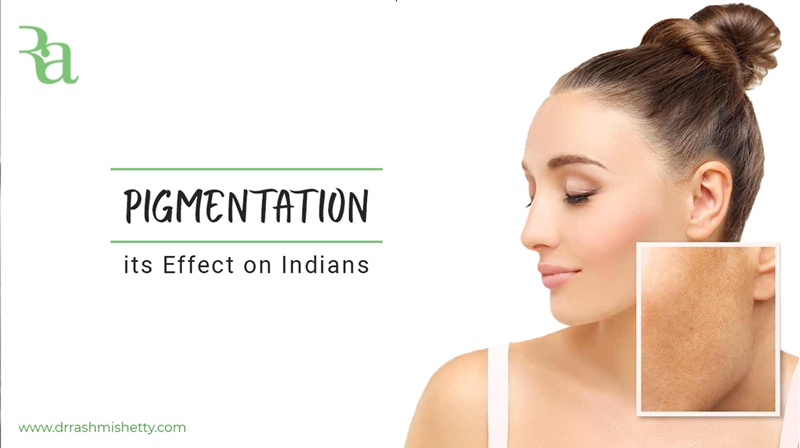Causes of Hyperpigmentation: Decoded!
Pigments are colours that occur naturally in animals and plants. The glimmering golden colour of a goldfish, the vivid crimson of a fresh rose or the brilliant blue and green of a peacock’s feather all come from pigments.
Similarly, in human beings, a pigment called melanin gives colour to our skin, eyeballs, and hair. And, this colouring of the skin, ranging from light to dark brown, is known as pigmentation. Our skin has special cells called melanocytes; whose duty is to make melanin.
When melanocytes dysfunction or get damaged, 3 types of pigmentation problems can show up on your skin.
Hyperpigmentation: a skin condition which makes the melanocytes go into overdrive and release extra melanin.
Hypopigmentation: a skin condition which causes patches of skin loses its pigment as the melanocytes slow down the production of melanin.
De-pigmentation: the skin starts losing its melanin pigment from patches of the skin leading to diseases like vitiligo.
There are two types of melanin
- Eumelanin, which gives a rich brown colour to our skin when exposed to the sun.
- Pheomelanin, which gives a red hue to the skin when exposed to the sun.
Multiple studies have suggested people of colour like us Indians are most susceptible to hyperpigmentation than other races because of the abundant presence of eumelanin in our skin. So, today we will reveal the culprits that are causing our skin to develop spots and patches of darkness.
Sun Exposure
Geographically, India is located quite close to the equator. So, the tropical country receives a good amount of sunshine throughout the year. Sunlight is essential for keeping us in a stable, happy mood and for the synthesis of Vitamin D in our bodies. However, the ultraviolet rays of the sun, which are invisible to the human eyes, are detrimental to the health of our skin. In an attempt to protect itself from the cancerous UV rays, our skin produces melanin. As a result, we get tanned or sunspots- two types of hyperpigmentation.
Tips:
- Do not leave the house without applying a generous layer of sunscreen and reapply after every 2-3 hours.
- Physical barrier to the sun’s rays is the best way to protect you from the detrimental effects of the sun. So, put on those sunglasses, protective gloves, hats and scarves.
Post-inflammatory hyperpigmentation
Inflammation is our immune system’s response to an irritant or wound on our skin. When the skin swells up slightly, turns red and hurts then, we say the skin is inflamed. The skin can experience an inflammatory reaction from –
- Acne
- Atopic dermatitis
- Psoriasis
- Lichen planus
- Pityriasisrosea
- Cosmetic irritant
- Allergic contact
- Photo contact-dermatitis
- Insect bites
All these conditions can leave behind scars and spots once they heal. These dark blemishes are known as Post-inflammatory Hyperpigmentation. They can stay on your skin from a few months to years to come. However, the good news is with the right treatment; they can fade away in a jiffy.
Tips:
- Vitamin C is a fabulous remedy to lighten dark spots and even out your skin tone. We recommend investing in a quality vitamin C supplement like Solskin Corp’s Ra Vitamin C Plus.
- Include a niacinamide serum or cream in your skincare regimen.
Frictional Melanosis
Continuous friction or rubbing against the skin can stress the skin to cause it to darken. The inside of the thighs turning dark is a good example of frictional melanosis. The thigh’s skin, especially for those with heavy thighs, rubs against each other causing it to darken.
It can also be seen commonly around the neck, clavicle area, nape, and elbow. Tight clothing, aggressive use of body brushes and loofah, resting an area on a hard surface over long periods can all cause frictional melanosis.
Tips:
- Be aware of your instinct to scratch continuously and remind yourself to not do it.
- Wear lose clothes which are made of soft, skin-friendly materials.
Nutritional deficiency
A lack of vitamin B12, vitamin C, folic acid and vitamin E can all lead to hyperpigmentation of the skin. A balanced and nutrient-dense diet can help. However, sometimes it is not enough because your body fails to assimilate those nutrients. This is when you should visit a dermatology clinic wherea doctor can suggest you the right supplements to tackle your condition.
Tips:
- Supplements like Ra Vitamin C Plus and Ra Skin Bright are a fool-proof way to deal with your deficiencies and bring back the brightness of your skin.
- We also recommend consulting Dr. Shetty either in person or on a video consultation to get yourself the perfect supplement.
Hormones
There are two female sex hormones, namely, oestrogen and progesterone, which mainly affect skin pigmentation. Usually, when a woman is pregnant, receives hormone replacement therapy or happens to be on birth control pills, these two hormones shoot up. As a result, one may start seeing dark patches on their skin, especially on the areas exposed to the sun. This condition is known as melasma or chloasma.
Tips:
- This is serious ground, and you do not want to experiment with DIY’s here. Consult a dermatologist.
Auto-immune Disorder
Our bodies are blessed with their immune system, which shields us from infections and diseases by attacking foreign cells. However, sometimes the system gets completely confused and starts attacking our body cells. Such a condition is known as an auto-immune disorder. Some of these conditions that impact the skin are
- Vitiligo – the immune system starts attacking the melanocytes of the body, leaving patches of skin devoid of any colour.
- Scleroderma – the disease causes the skin to thicken, harden and tighten to adopt a smooth and shiny appearance.
- Discoid lupus erythematosus – the skin gets crowded with coin-shaped lesions that are itchy, scaly, red and painful.
- Cutaneous Vasculitis – it shows up in the guise of red or purple ulcers which can be painful and itchy.
Acanthosis Nigricans
Notice your armpits, the back of the neck and groin getting darker. Well, there’s a name to that condition when the skin in the creases of your body turns to think and dark with an almost velvety appearance. It is Acanthosis Nigricans. It usually affects people on the heavier side of the weighing scale and those who have diabetes.
Tips:
- Manage your weight.
- You can use rosehip oil which is packed with natural vitamin A and C to keep the area moisturized and lighten over time.
Cutaneous Amyloidosis
Proteins are great, aren’t they? The building block of our body! However, not all of them are as virtuous. There are quite a few villains of insoluble protein which clump together to form amyloids. They usually show up as skin small red, waxy lesions. Sometimes they pop up in the shins, thighs, feet and forearm as dark brown clumps of papules that are scaly and itchy.
There are plenty of tips and tricks on pigmentation that you can pick from Dr. Shetty absolutely free by following her Instagram handle @drrashmishettyra.
In conclusion, there are a plethora of factors that can cause hyperpigmentation on your skin. While some might think it is a simple aesthetic bumper which brings down your self-confidence at most, however, what most people don’t understand is the fact that hyperpigmentation is often a surface indication of complicated health issues within you. So, do not ignore its presence. Consult a skin doctor before concocting your home remedies that can do more harm than good.
We are going to come up with a lot more content on pigmentation in this space, so, stay tuned for more.













Leave a Reply
Want to join the discussion?Feel free to contribute!